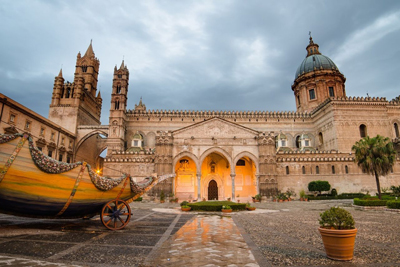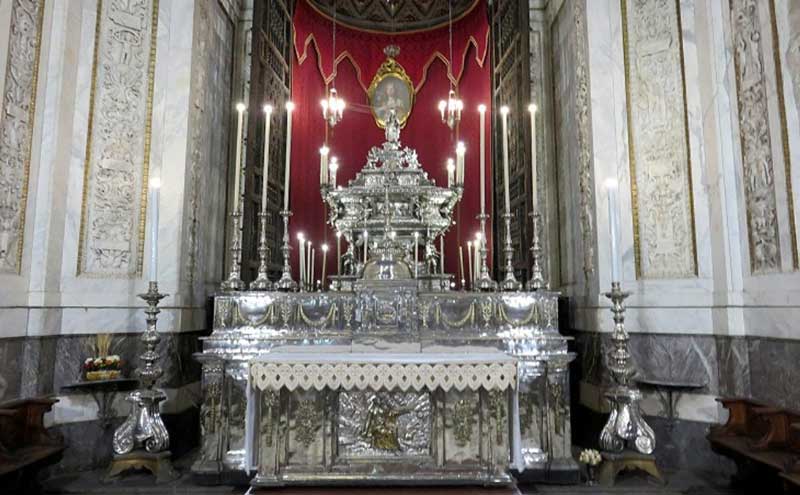
The Duomo of Palermo, popularly known as the Palermo Cathedral, dedicated to the Assumption of the Virgin Mary, is an impressive Catholic church of the Roman Catholic Archdiocese of Palermo in Sicily that exhibits a wonderful amalgamation of different architectural styles. Decorated with multiple geometric patterns, colourfully designed cupolas, and blind arches, the massive church is the western part of the historic centre of Palermo, located close to the Royal Palace and the Palatine Chapel. Although the structure is a grand feast for the eyes, its long history of additions, alterations, renovations, and restorations is responsible for its wide variety of architectural styles.

Initially, the site of the church was occupied by a Byzantine basilica, probably founded by Pope Gregory I, which was turned into a by the Saracen Muslims after their conquest of the city in the 9th century. The present building of the Palermo Cathedral was built on the location of the 9th-century mosque, a column of which still exists at the southern porch of the church, inscribed with a passage from the Quran. The construction of the Palermo Cathedral began in 1185 by Walter Ophamil or Walter of the Mill, Italianized as Gualtiero Offamiglio, the Norman archbishop of Palermo, who was once the tutor of King William II. He had immense power and enough funds, and he had the vision to create a church that would be more, or at least equally magnificent like the Cathedral of Monreale. Finally, the enormous size and the external grandeur of the cathedral became a statement of the power struggle between the church and the throne, a potentially dangerous situation that was tempered by the death of Walter, who passed away in 1191 before the completion of the church building.

Over the centuries, the original building of the Palermo Cathedral was modified with numerous additions and renovations. Its present neoclassical appearance mainly dates from the massive work carried out between 1781 and 1801by Ferdinando Fuga and Giuseppe Venanzio Marvuglia. During that time, the friezes and relief works were destroyed, and the decorative statues, created by the famous Italian Sculptor Gagini, were removed to different parts of the basilica. Ferdinando Fuga also created the great dome of the cathedral emerging from the main body of the building, along with the other domes covering the ceilings of the aisles.

While the western entrance of the cathedral, assuming the appearance set in the 14th and 15th century, is flanked by two towers, a Gothic portal surmounted by a niche with a precious 15th century Madonna, the southern side of the cathedral, currently serving as the main entrance, was erected around 1465 and is equipped with outstretching turrets, a wide portico in Gothic-Catalan style with three arcades. The entrance is fronted by gardens and a statue of Santa Rosalia, one of the patron saints of Palermo. The façade, clamped between the high towers with mullioned windows with a vertical strip between the panes, and columns are joined by two pointed arches to the bell tower that faces it.

Enclosed by the turrets, the area around the apse is part of the original 12th-century building, while the subsequently constructed part of the church is on the left, which is evident with its early 16th-century portal. The interior of the church, essentially a marble shell, is constructed in the pattern of a Latin cross plan with a nave, a transept, an apse, and two aisles, divided by pilaster. The Sacrament Chapel, located at the end of the left aisles is gorgeously decorated with precious stones and lapis lazuli, and the Chapel of Saint Rosalia, equipped with a richly ornamented bronze gate and a 17th-century silver urn, is located on the right. The chapel is embellished with an altar of solid silver and contains the relics preserved in a silver sarcophagus, reported to be weighing 1298 Sicilian pounds. The crypt, assessable from the left, is a room with a cross vault and supported by granite columns, contains several tombs and sarcophagi of Roman, Byzantine, and Norman ages, which includes the remains of Walter Ophamil, the founder of the church. However, the first chapel on the right contains six royal tombs that include the tomb of Roger II, the first king of Sicily, who was crowned in the Duomo in 1130. Squeezed into an enclosure by the south porch are the mortal remains of Queen Constance I of Sicily, the daughter of Roger II, her husband Henry VI, the emperor of Germany, their son Emperor Frederick II, Frederick’s first wife Constance of Aragon, and his great-grandson Emperor Henry VI.

Assessable from the south transept the Tesoro or the treasury of the cathedral is a treasure trove, a repository of numerous vestments, silverware, chalices, holy vessels, altar cloths, and ivory artifacts of Sicilian art of the 17th century. Today, it has turned into a small museum containing illuminated manuscripts, bejeweled chalices, and crucifixes, apart from the sophisticated gold jewelry adorned with Byzantine enamel-ware, bejeweled rings of the queens, and even a few metal icons. However, the famous exhibit of the museum is the crown of Queen Constance of Aragon, which was removed from her head, when her tomb was opened in the 18th century.